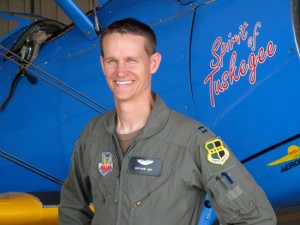Up in the Sky! Tuskegee Airmen Plane Barnstorms Into the Smithsonian Collections
The Stearman biplane will be put on display when the museum opens on the Mall in 2015 and will remain a vivid, perpetual tribute to the Tuskegee Airmen
Having written the Smithsonian magazine column The Object at Hand for several years, I’ve been able to tell the stories behind a wonderful array of fascinating things in the many collections of the Institution’s museums and galleries. But the things I write about are carefully preserved and protected for the good of history, so I am not allowed to lay my ink-stained fingers on them.
Until now. A few hundred feet above the rolling hills of Northern California all that changed.
So, there I sat, in the front seat of an open-cockpit, tandem seat World War II era Stearman PT-13D biplane, on the tarmac of a civilian airport in Lincoln, California, fanned in the 99-degree heat by the prop of the ten cylinder Lycoming radial engine. In the seat behind me, at the controls, was Matt Quy (pronounce Kwai), a 35 year-old Air Force captain on active duty with a combat reconnaissance squadron at a nearby base. Quy bought a crashed plane at auction six years ago, discovered that it had been used as a trainer for the African American flyers who have come to be known as the Tuskegee Airmen and decided to take it back to its original condition as a tribute to America’s first black military pilots.
Back from a tour in Afghanistan and stationed with his wife Tina in Louisiana, Quy began devoting the lion’s share of his off-duty hours to meticulously restoring Stearman number 18303. He and an aircraft mechanic friend in Houston, Robbie Vajdos, repaired the pre-auction damage that had occurred when the plane’s engine failed and a landing on a road ended with a head-on into a tree. To give due credit, Tina took a hand in some of the work.
“Luckily for me,” Quy says, “after the war many of these planes became crop dusters, so there are still parts available.”
Quy recounts that he’d wanted a Stearman biplane since he was a kid in Minnesota. “My family lived near a grass landing strip, and there was a guy with a Stearman who dragged advertising signs. He’d come right over our house pulling these banners, and I was hooked.”
Restoring the plane became both a labor of love and an act of homage to the men who had trained in it. The bright blue, red and yellow paint scheme recreates the wartime colors, and Quy has used the plane, which took to the air again three years ago, as a way of educating young generations about the Tuskegee pilots, appearing at air shows to tell the story of the African-American flyers. He has met many of the surviving pilots who flew the Stearman trainers, and on the lid of the plane’s luggage compartment there are Magic Marker signatures of many of them.
As we sat at the end of the runway to build up the old engine’s revs, the pilot of a sleek business jet radioed to ask if he could go ahead of us, since he’d just been cleared by the Lincoln tower. Capt. Quy waved him on with a thumbs up, and the jet’s pilot radioed back: “Thanks, Gentlemen…I sure would like to trade places with you.”
I wouldn’t have traded places for the world. After all, a jet is just a jet, but a Stearman biplane is…well, it’s living history. And fun! With four wide lift surfaces, the plane seemed as buoyant as a kid’s kite (and just as magical to look at). Quy, an experienced aerobatic pilot, gave me the thrill of “barnstorming,” taking the plane down to about 100 feet over the golden fields and skimming up and over the eucalyptus trees lining a creek fed by the snow melt off the Sierras. A coyote rushed out of the brush down below and looked up in astonishment. Or could it have been envy? Given enough gasoline, I’d have gladly stayed in that wonderfully reclaimed beauty until dark.
This was likely the Stearman’s final penultimate flight out of Lincoln Airport. On Saturday, July 9, Quy will climb into the cockpit with a friend, and take off from Lincoln a nearby Air Force base en route to Washington, DC, where the plane will be turned over to the curators of the new National Museum of African American History and Culture. It will be put on display when the museum opens on the Mall in 2015 and will remain a vivid, perpetual tribute to the Tuskegee Airmen. On his way, he will stop in Colorado, at the Air Force Academy, where eight Tuskegee veterans will be waiting to salute him (and vice versa).
Quy admits parting with the plane will not be easy, but he has already bought another Stearman, and with it he will create a second educational project, this one devoted to the pilots who became prisoners of war or went missing during the Vietnam War.
– by Owen Edwards
Owen Edwards is a freelance writer and author of the book Elegant Solutions. Each month in Smithsonian magazine, he selects one artifact from among the Smithsonian Institution’s 23 million and tells its story.
